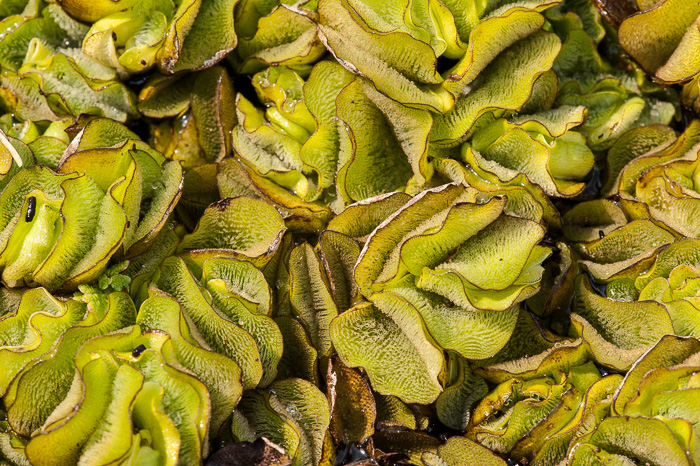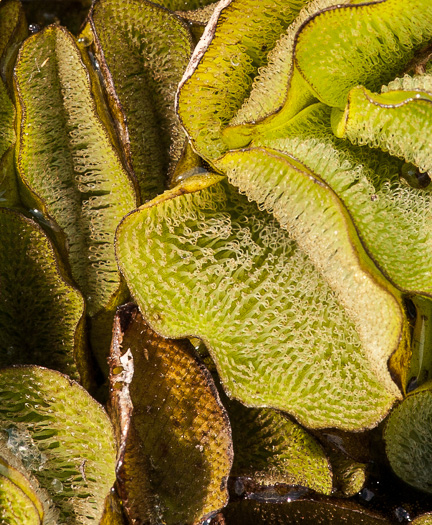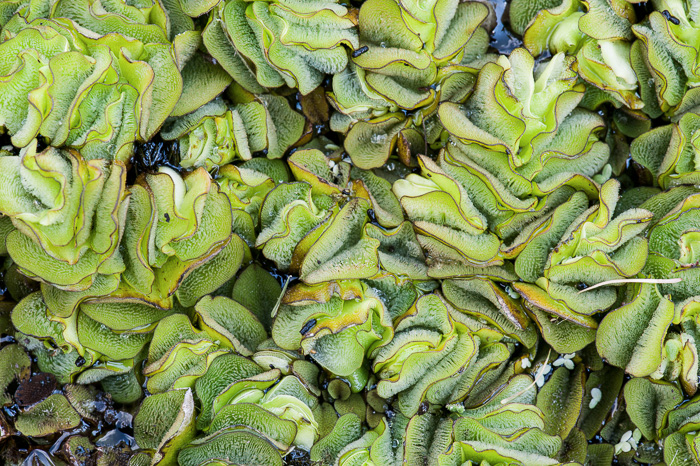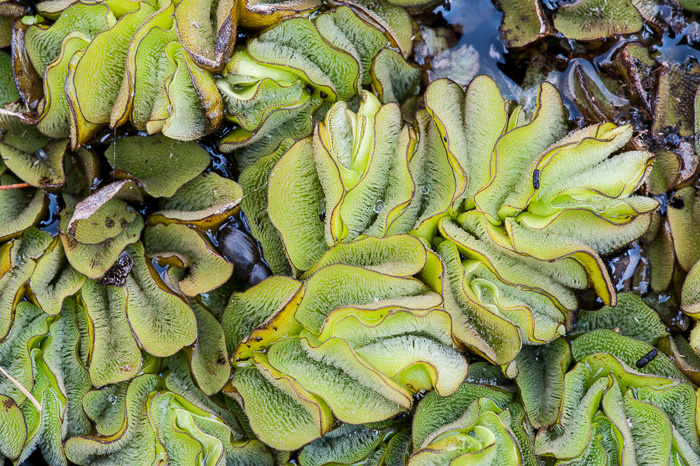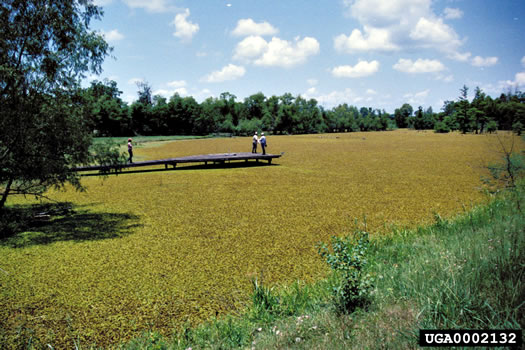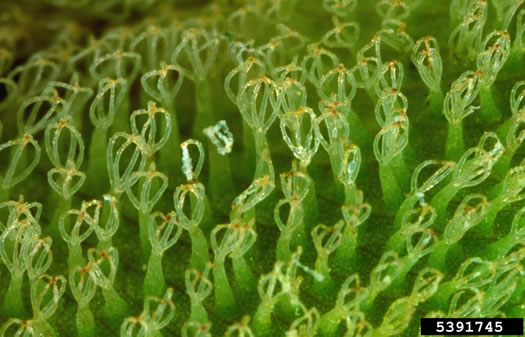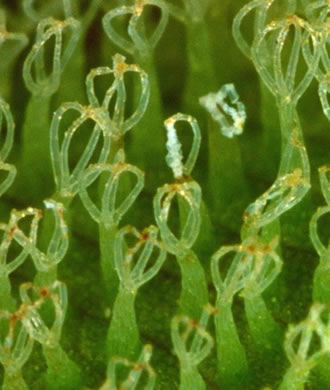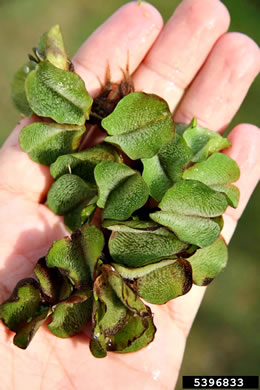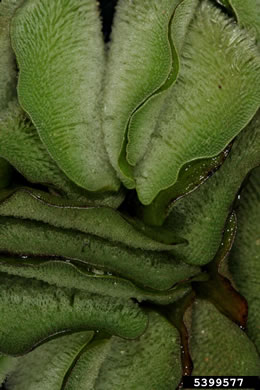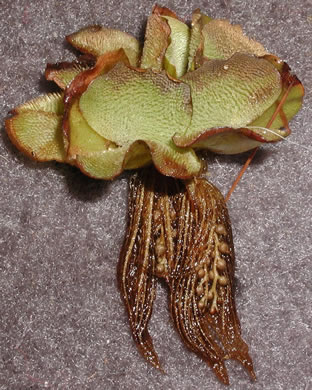Monilophytes (ferns): Leptosporangiate Ferns (true ferns): Salviniales
WEAKLEY'S FLORA OF THE SOUTHEASTERN US (4/14/23):
Salvinia molesta
FAMILY
Salviniaceae
Go to FSUS key
Dig deeper at SERNEC, a consortium of southeastern herbaria.
See herbarium specimens at the Atlas of Florida Vascular Plants
See more pictures at www.invasive.org.
Check out EDDMapS.org to see where this has been reported.
Learn more about Giant Salvinia from the Vascular Plants of North Carolina.
Leaves borne in 3s; appear 2-ranked, but with 3rd leaf finely dissected and dangling, resembling roots. Read more at Center for Aquatic & Invasive Plants.
Salvinia is a floating aquatic, with leaves borne in whorls of three, two of which are the conspicuous floating leaves, to 5 cm long, and round or elliptical; the third leaf is dissected and pendant into the water. S. molesta is considered a noxious aquatic weed. Read more in Weakley's Flora (2023).
SYNONYMOUS WITH
PLANTS NATIONAL DATABASE:
Salvinia molesta
FAMILY
Salviniaceae
SYNONYMOUS WITH Floristic Synthesis of North America. BONAP (Kartesz, 2021)
Salvinia ×molesta
SYNONYMOUS WITH Floristic Synthesis of North America. BONAP (Kartesz, 2015)
Salvinia molesta
SYNONYMOUS WITH The Ferns and Lycophytes of Texas (Diggs & Lipscomb, 2014)
Salvinia molesta
SYNONYMOUS WITH Floristic Synthesis of North America (Kartesz, 1999)
Salvinia molesta
SYNONYMOUS WITH Flora of North America north of Mexico, vol. 2 (1993)
Salvinia molesta
(?) -
Salvinia adnata
COMMON NAME:
Giant Salvinia, Kariba Weed
To see larger pictures, click or hover over the thumbnails.
Ted D. Center, USDA Agricultural Research Service, Bugwood.org bug_0002132
Month Unknown
Dense, rapidly growing surface mats block sun to bottom plants and animals, per Invasive Plants, Guide to Identification, Impacts and Control (Kaufman & Kaufman, 2007).
![]() COMPARE
aquatic plants
COMPARE
aquatic plants
Barry Rice, sarracenia.com, Bugwood.org bug_5391745
Month Unknown
Hairs of upper leaf w 4 branches joined at tips, forming a cage-like structure, per Weakley's Flora.
Barry Rice, sarracenia.com, Bugwood.org bug_5391745b
Month Unknown
Hairs on the leaf surface are shaped like egg beaters, per Invasive Plants, Guide to Identification, Impacts and Control (Kaufman & Kaufman, 2007).
![]() COMPARE
Salvinia species
COMPARE
Salvinia species
Robert Vidéki, Doronicum Kft, Bugwood.org bug_5396833
Month Unknown
Shade-grown leaves lie flat; sunlight and crowding cause crumpling, per Invasive Plants, Guide to Identification, Impacts and Control (Kaufman & Kaufman, 2007).
Leslie J. Mehrhoff, University of Connecticut, Bugwood.org bug_5457880
Month Unknown
Perhaps introduced as plants sold to aquarium and koi pond owners, per Invasive Plants, Guide to Identification, Impacts and Control (Kaufman & Kaufman, 2007).
WEAKLEY'S FLORA OF THE SOUTHEASTERN US (4/14/23):
Salvinia molesta
FAMILY
Salviniaceae
SYNONYMOUS WITH
PLANTS NATIONAL DATABASE:
Salvinia molesta
FAMILY
Salviniaceae
SYNONYMOUS WITH
Floristic Synthesis of North America. BONAP (Kartesz, 2021)
Salvinia ×molesta
SYNONYMOUS WITH
Floristic Synthesis of North America. BONAP (Kartesz, 2015)
Salvinia molesta
SYNONYMOUS WITH
The Ferns and Lycophytes of Texas (Diggs & Lipscomb, 2014)
Salvinia molesta
SYNONYMOUS WITH
Floristic Synthesis of North America (Kartesz, 1999)
Salvinia molesta
SYNONYMOUS WITH
Flora of North America north of Mexico, vol. 2
Salvinia molesta
(?)
-
Salvinia adnata
If a search such as "Carex leptalea var. leptalea" doesn't deliver the results you want, try "Carex leptalea".
Or, to minimize chances of a misspelling, try just "Carex le".
Less is more: If "pencil flower" doesn't deliver the results you want, try "pencil".

